|
FAQs on
the Blue, Three-Spot, Gold/en, Opaline, Even Albino! Gouramis, Yes, The
Same Species, Trichogaster trichopterus, Disease/Health 3
FAQs on Trichogaster Disease:
T.
trichopterus Disease 1, T.
trichopterus Disease 2, T. trichopterus
Disease 4,
FAQs on Trichogaster Disease by Category:
Diagnosis,
Environmental,
Nutritional,
Social,
Infectious,
Parasitic,
Trauma,
Treatments
Related Articles: Anabantoids/Gouramis & Relatives,
Genera Ctenopoma &
Microctenopoma, Betta splendens/Siamese
Fighting Fish,
Related FAQs:
Trichogaster
trichopterus 1, Trichogaster
trichopterus 2, T. trichopterus
ID, T. trichopterus Behavior,
T. trichopterus Compatibility,
T. trichopterus Selection, T. trichopterus Systems, T. trichopterus Feeding, T. trichopterus Reproduction,
Gouramis 1, Gouramis 2, Gourami Identification, Gourami Behavior, Gourami Compatibility, Gourami Selection, Gourami Systems, Gourami Feeding, Gourami Disease, Gourami Reproduction, Betta splendens/Siamese Fighting
Fish,
|
[1]%20tric.jpg)
|
|
Sick Golden Opaline Gourami 1/19/12
Hello WWM Crew!
<Alicia>
I've successfully used your site before to help in the
diagnosis and treatment of freshwater aquarium fish before and I
tried to do so once again this time, but to no avail. I
couldn't find an article that seemed to fit with the symptoms
presented by my golden Opaline gourami (Trichogaster
trichopterus).
I've had this gourami for over a year now. At the moment, its
still very active and eats plenty when fed, and still enjoys
terrorizing the other fish in the aquarium. Its also the biggest
and most aggressive fish in the aquarium. Probably a month ago, a
few light colored wounds appeared on the left side, around the
fish's dorsal fin and extending down in stripes toward the
lateral line. They seem to be steadily getting bigger and
spreading.
I've discounted fighting because this fish is the biggest and
most aggressive in the aquarium. The tankmates are 6 harlequin
Rasboras, 1 platy, 1 turquoise rainbow and 2 Corydoras. I did
have 2 of the rainbows, but I came home today to find one dead. I
have a bad feeling that it is probably related to the
gourami's illness.
<Could well be>
I try to keep the stats of the aquarium as consistent as
possible. The temperature is usually around 75 degrees Celsius,
the pH 7.0. The water is soft,
<How soft? I would adjust make up water to raise a bit if too
so. Please read Neale's piece here re:
http://www.wetwebmedia.com/FWSubWebIndex/fwhardness.htm
and the first few Related FAQs files linked above>
and I have to use a buffer to keep the water at 7.0. The ammonia
and nitrates are at 0 ppm.
I've tried two different anti fungal medicines (Pimafix and
Rid Fungus).
I've also tried Melafix and Quick Cure. I do a 25% water
change every week and I've been checking the water as often
as possible. I'm attaching some pictures to see if they might
help.
Thank you in advance for all your help!
Alicia
<Mmm, though your description of circumstances doesn't
point to a root cause, this may be a bacterial infection...
"just" stress induced... OR perhaps Costia... Do see
the Net in general, and WWM in particular re: http://www.wetwebmedia.com/FWSubWebIndex/CostiaF.htm
The API "Fixes" you used are worthless, but the Quick
Cure... Formalin component should have done something, either
killed off your bio-filter and likely your fishes if used and not
absorbed... Bob Fenner>
|
|
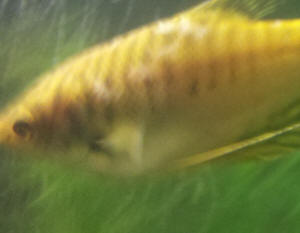 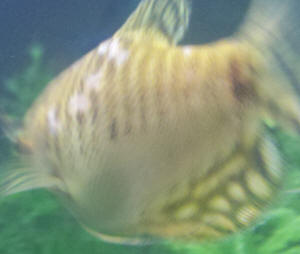
Re: Sick Golden Opaline Gourami 1/20/12
Hi again!
<Alicia>
I think you may be right about the bacterial infection. I've
started a treatment of Maracyn and Maracyn Two, to over the gram
negative and gram positive bacteria.
<Good>
I gave them a dose last night, and so far, no one has kicked the
bucket.
Oddly enough, the Quick Cure didn't seem to do much beyond
turn the water blue. The gourami stayed the same through two
courses of treatment. The biofilter seems to still be in working
order, but I supplement it when I do my weekly water change with
Safe Start.
<Thank goodness>
I'll keep you posted! Thank you for your advise and the
articles. Your site is always very informative!
Alicia
<Thank you, BobF>
|
|
Gourami problem 1/2/12
I have stumbled across your excellent website late this evening
and wondered if you could please give me some advice ?
<Surely.>
I was given 3 large gouramis
<Trichogaster trichopterus; males of this
species can be extremely aggressive. Despite being widely sold, I
don't recommend them.>
and 3 Corydoras
<By contrast, these are excellent fish, but do keep more than
5 of each species of Corydoras. Bronze and Peppered Corydoras are
the two easiest to keep and widely sold. Prefer coolish
conditions, 22-25 C/72-77 F, and don't do well
overheated.>
in a bit of a rush when someone moved house and I wasn't
really prepared.
As a novice to be honest the filter was too small and I
hadn't realised that you needed to change the tank water so
often
<What do you mean "so often"? When the tank is
matured, so after 6 weeks of running with an ammonia source (such
as small daily pinches of food) the aquarium only needs 20-25% of
the water changed every week or two. Compared to a dog or cat,
this is minimal effort pet-keeping. But no, you can't ignore
a fish tank for months at a time.>
and the quality did go down even though there weren't many
fish and it never looked dirty/cloudy. I took a water sample to
our local aquatic centre and found out everything when
one gourami got a ragged pectoral fin and bit of white
rot and a clouded eye.
<Fighting and/or water quality issues. Finrot is common when
you have non-zero ammonia and nitrite levels. Fighting creates
wounds, and these make Finrot even more likely.>
When the stripey one got what looked like a bite in it's tail
I decided to take action and invest properly in a new big tank as
I really enjoyed this new hobby ! I read that the best therapy is
to make sure the tank water is correct
<Yes; or rather, of water quality isn't right, any amount
of medication won't help.>
so I have now set up a nice tank with a new filter and when I
test the water with the tetra strips the water quality seems all
fine.
<I need numbers!>
In total there are the 3 gouramis, 5 platy type live-bearing fish
(?), 3 Corydoras and 1 Plecostomus in 120L tank.
<Would return the Plecostomus as soon as you can. It
doesn't belong here and will reach at least 30 cm/12 inches
in the first year and 45 cm/18 inches within two years. If you
must have an algae-eater, get a Bristlenose Plec, Ancistrus spp.,
as these are small (10 cm/4 inches is typical) and very easy to
look after. But do also be aware algae-eaters aren't
essential and don't help that much. Snails (specifically,
Nerite Snails) are much better, and fast-growing plants best of
all.>
The stripey's tail bite took ages to heal up and when I
decided to get the larger tank they all had places to hide and
weed to hide in and all seem much happier now especially with the
new 5 confident fish. (I've attached a pic as I'm not
sure what they are !)
<The dumpy-looking things with the Mickey Mouse markings on
their tails are Platies. Keep at least two females per male, or
else just females. Males have a tube-like anal fin, whereas that
of the female is triangular. Nice fish, and like the Corydoras,
need to be kept slightly cooler than average.
Must have hard, alkaline water -- not soft, acidic water.>
Anyway, the tail has started to heal but the skin around it
started to take on a black discolouration. The tail fin itself is
still ragged. Also the black colouration is now spreading along
the lower anal fin. However, strangely the fish has started to
get back it's bright spots of orange within the black which
is heartening and does eat OK (tropical fish flakes and frozen
tropical food like blood worms or larvae). I thought it could be
something like a black velvet disease but the skin isn't
fluffy. I looks like the dark area might separate from the other
and fact it's "spreading" is a bit worrying.
<A mix of Finrot and Fungus; treat for both. In the US,
Seachem ParaGuard for example treats both; here in the UK, I use
a product called eSHa 2000.
Otherwise use an antibiotic and an antifungal at the same time.
Don't waste time with tea-tree oil products at this point (so
no Melafix, Pimafix, etc.); while these might be worthwhile at
preventing infection when a fish has been damaged but is
otherwise fine, once symptoms of infection become apparent, you
need to use something more reliable.>
It likes to hide more and I think it's a female. There is one
other larger blue female (smaller rounded dorsal fin) and a large
orange male (long pointed dorsal fin) both of which seem healthy
now. The blue's pectoral fins have all repaired now that the
new tank is clean and water quality good.
Please, please could you have a look at these pictures and tell
me whether I should be treating the stripey gourami ? Is the
reddish colouration a worry around the gill flap as it looks
slightly sunken ? Or should I wait and see, given that the
colouration is coming back ?
Many thanks
Amanda
<Treat now. Also review fish stocking, and add/remove fish as
required.
Cheers, Neale.>
|
|
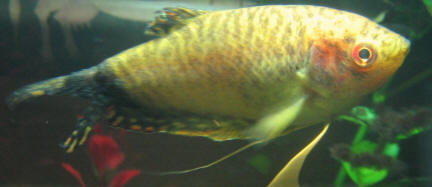 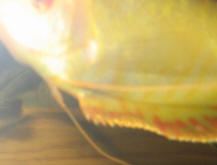
Re: Gourami problem --
1/3/12
Neale, you are fantastic ! Thank you so much for your advice
!
<Glad to help.>
There is so much information around and too many forums where
everyone is having a guess and not much concrete info for a
novice like me.
<There's much to be said for buying one or two really good
books, and trusting that book, at least for the first year or
two.
http://www.wetwebmedia.com/fwsubwebindex/bksfwbrneale.htm
I happen to like Baensch's Aquarium Atlas vol. 1 as a good
primer, but there are other options as well, some written for
absolute beginners, others for more ambitious starters.>
I'm really enjoying finding out about everything though... I
do change about 20% of the water usually every week and check the
strips (those Tetra 6 in 1 strips) against the bottle colours
(NO3 25, NO2 0, GH 8, KH 6, pH6.8, Cl2 0.8); it's very hard
water where I live).
<Which is fine, good even. Hard water tends to be very stable,
so pH fluctuation can be something you can ignore. Merely choose
fish species that like hard water. But looking at your aquarium
readings above, 8 degrees dH for general hardness and 6 degrees
KH for carbonate hardness aren't especially high, and your
water should be fine for a wide variety of fish. I'd not go
with livebearers (platies, guppies, etc.) because your pH is
acidic for some reason, but barbs, tetras, gouramis, Corydoras,
etc. should all be fine.>
When I said "large" Gouramis they are about 4.5"
long nose to tip of tail. I now realise there are even bigger
ones so I may have misled you'¦.
<No, I do know how big this species gets. Yours is about full
grown.>
I think the snails are a good idea too but will wait to get these
until after sorting out the stripey problem with the eSHa.
<Wise. Nerite snails are excellent algae eaters and don't
breed in freshwater, but they are quickly killed by copper, so
it's a good idea to settle in all your fish and make sure
they're healthy before adding these snails. Same goes for
shrimps and most other invertebrates.>
I'm enjoying the plant life as well as the fish so don't
want to go in for loads of fish but I do want to keep the few
I've got healthy and happy - good to know the Corydoras were
a good hardy choice but they are getting quite big (around
2" but possibly stopped growing now).
<Depends on the species. Most get to between 5-8 cm, 2-3
inches.>
Thank you very much once again. It's so nice to get some
positive advice that I can act upon. I've ordered the eSHa
2000 and just off to sex the platies and look up Bristlenose
Plecs !!
<Cool.>
Thank you once again and I'm hopeful with a bit of TLC I can
get the fish healed up.
Best wishes and Happy New Year !
Amanda Wright
<Thanks for the kind words. Cheers, Neale.>
|
Golden Gourami is acting paralyzed
9/17/11
I don't know what to do. I have searched for any kind of answer to
explain what might be going on with my Golden Gourami. It was perfectly
fine this morning, but tonight it has started acting as though it is
paralyzed.
<Is it lying down on its side? Or the right way up but simply not
swimming normally?>
It will not use its back fins for anything. It manages to get to the
top of the tank and will attempt to eat but cannot stay up long.
Besides all that the fish looks healthy. I haven't had a fish die
on me in two or three years. All the other fish in this tank are
perfectly fine, and I checked everything I could with the water and
they all came back good. Can you please help me.
<This is a tough one. Fish lose the ability to swim normally for a
variety of reasons. Do the usual things: Review water temperature,
chemistry and quality. Check the social behaviour of the other fish.
Think about toxins, including airborne ones like paint fumes. Physical
damage like swimming into the hood when alarmed can cause damage to the
spine. In the meantime, keep a close eye on the fish, but don't
medicate unless you're sure there's a disease, and I'm not
sure there is. Some details on the aquarium and tankmates would help
with diagnosis. Cheers, Neale.>
Re: Golden Gourami is acting paralyzed 9/19/11
It is not laying on its side , it keeps moving but when it tries to go
toward the surface it will flip upside down or spin in circles. The
other fish are two blue Gourami, two Opaline Gourami, a kissing Gourami
and two brown knives. These are in a 55 gallon tank
<Does sound serious'¦ like the fish has been poisoned.
Review environment, toxics as discussed before. Cheers, Neale.>
Re: re: Golden Gourami is acting paralyzed 9/19/11
Thanks for all your help. My golden Gourami ended up not making it,
will keep an eye out on other fish though.
<Glad to help. Do review conditions in the aquarium, and hold off
buying any more fish for at least 6 weeks. Cheers,
Neale.
gold Gourami 9/15/11
Hello Neale, Chris here. Two quick questions for you. My Gold Gourami
has red muscle near the front fins, is this natural or is there
a problem here?
<It's not unusual for many fish to have a red band along the
"join" between the body and the fin. Obviously inflammation
indicates irritation, but if the fish is otherwise normal, and the red
is the colour of the blood rather than inflammation, it's
normal!>
Also when having live plants, is it necessary to use a Co2 system for
them to thrive?
<Yes and no. There are many plants that will only grow under bright
light, and most of these also need CO2 as well. The brighter the light,
the more CO2 a plant needs, and above a certain light intensity, there
isn't enough CO2 in the water coming from the fish alone. On the
other hand, there are plenty of plants that can muddle through with
just the ambient CO2 from your aquarium fish. These tend to be the low
to middling light plants often recommended to beginners -- hardy
Cryptocoryne species, some of the Amazon swords, Vallisneria, Java
ferns, Anubias, etc. So yes, if you choose carefully, you can have a
lush green aquarium without CO2, but the Amano-style tanks with the
more demanding plants generally rely on CO2.>
thanks again, Chris.
<Cheers, Neale.>
|
Parasites on three spot Gourami.
6/27/11
Hello Crew,
I've been reading and learning a lot from your website, thank
you so much for helping us and our fishes.
<Welcome>
I really need your help in identifying the parasites my fish
might have. I have 4-4.5 year old three spot Gourami that has
been healthy and hardy fish for all these years until recently. I
made some bad choices and introduced a fish to his tank that he
was extremely afraid off. He will not come to surface to eat and
got very stressed.
I set up a new 20 gallon tank just for him and transferred the
fish in it once it cycled (water quality is good with 0 for
ammonia and nitrites and under 10 for nitrates), ph 7.5 hard
water with moderate alkalinity.
After the transfer the fish showed signs of irritation, scratched
himself over objects in the tank and soon after develop
small raised white-grayish spots very similar to
Ick but not Ick. I tried to raise the temperature to 88F and
adding salt to 0.7% but it did not help. Under these conditions
it looked like he is getting more spots and they also grow
larger. They do fall of the fish leaving scars with a little
bleeding. The new spots will appear mostly on the old wounds or
close to gill covers. I have three black tetras with no signs of
disease, so it either something specific to gouramis or the
parasites are not leaving the fish?
<Likely so>
As far as the treatments I've tried so far: 2 weeks of raised
temperature plus salt-did not work; 4 treatments with parasite
clear tank buddies by Jungle lab (Metronidazole, Praziquantel,
Diflubenzuron, Acriflavine) 48 hours apart with 25% water change
- did not do anything; Seachem Paraguard bath for 1 hour - took
most of external spots down. At that point I collected all that
stuff that come from the fish and looked at it under the
microscope. What I found was a few Trichodina like
parasites,
<Can you describe these? Size?>
a tiny microscopic worm (likely nematode) that was still alive in
the Paraguard water and tried to wiggle himself back into the
piece of dead skin-Ouch! Another creature was a tiny insect-like
thing (six legged one), but may be crustaceans of some sort.
<?!>
What a zoo and I'm still not sure what is going on.
I had to repeat Paraguard bath for two more times to take care of
the few leftover spots that would keep reappearing on the fish
skin and now his skin is clean and keeps healing well.
I also added the recommended amount of Paraguard to the tank
water every 24 hours for 3 days until The ammonia level raised to
.25. Damn, I trusted the Seachem for being filter safe and here
I'm. Did 50% water change, ran carbon with Nitrazorb and
added Prime and good squeeze off my established tank sponge. By
the end of the day the ammonia level was 0, and the rest of
parameters were all fine. That same day Gourami felt itchy at his
gills, he would go to the surface, inhale some air and blow the
bubbles through his gills. After doing this a few times I found
a worm dislodged from his gills. That worm is about 1 cm
long, and ~ 0.5-1mm thick, white-transparent looking. Has a
ventral sucker and may be dorsal sucker, half filled with blood
and other thicker half filled with some yellowish stuff (organs
or eggs). Could it be fluke?
<Yes>
Could they be so big?
<Rarely, but yes>
After that worm fall of the fish's gills the Gourami is not
eating, just takes the food and spits it out. Also not as active
as he used to be.
I'm sorry for such long email, just wanted to include all the
details.
I'm extremely desperate to save my fish, but feel that these
past 3 months were really stressful and I'm at my personal
water change limit.
Please, if you could help me to find the proper treatments for my
fish I would so much appreciate this.
<I'd go back w/ an Anthelminthic... the Praziquantel by
itself. Please read
here: http://wetwebmedia.com/FWSubWebIndex/AnthelminthicsFWF.htm
Thank you.
Sincerely,
Oxana
<Welcome. Bob Fenner>
Re: Parasites on three spot Gourami.
6/29/2011
Hi Bob,
<Oxana>
Thank you very much for your reply and all the info.
What I thought to be a Trichodina-like parasites, were round
single cell organisms of ~ 20-40 micrometer in diameter, some
were quite transparent with identifiable edge and some sort of
fluff around it, which made me think It could be cilia. Since
they've been seating in Paraguard treated water o/n, they
were dead and not moving. Other type were also round, but more
brownish in color (no horseshoe-shaped nucleus), but similar in
size.
This morning one more worm came off the Gourami's gills and
it looks nearly identical to the one I found before.
I looked at both of them under the microscope and the closest
look-alike organism I can find was Schistosoma sp. (I have
attached the image I found on the Web as well the photo I've
taken). Sorry, for the poor quality, It was taken with phone
camera.
<These look like flukes to me, with their prominent hooks...
definitely worms of some sort>
I also included few pics of my fish with those raised spots.
Could it be some sort of Trematode lifecycle form
(cercariae?).
<Possibly, yes>
I don't have any snails in the tank, so if indeed these
things are flukes, could they have fish as the only host?
<Yes>
I guess my hopes are that those worms may be do have some
intermediate host and the whole thing will just die off
eventually, if they can not complete the cycle.
<You are correct, if they have a complex life history>
I have ordered some Hikari liquid PraziPro, thank you very much
for your suggestions.
Sincerely,
Oxana
<Welcome. Bob Fenner>
|
|
 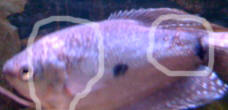 
|
|
Three-Spot Gourami's "swollen stomach"
and a "big red wound" on its right side.
6/16/11
Hello Crew,
Your team has done a wonderful job of helping fish enthusiasts.
Now I needed help regarding my three spot Gourami. My fish has a
big red wound on its right side and its stomach is swollen.
<Yikes... I see this in your pix>
Firstly around 6 months ago, there was just a little red mark
that remained whatsoever I did, and was constant (neither healing
nor deteriorating).Till then I had two Three spot gouramis. But
then one of my Gourami got a sort of pop eye and it
ultimately
resulted in its death. I used Epsom Salt as advised by you but
still its condition did not improved.
<... the environment...>
Now my this Gourami is suffering from I don't know what kind
(bacterial, fungal or viral) of infection.
<Likely secondarily bacterial...>
My aquarium stock
includes:
1 Three-Spot Gourami
1 Butterfly Koi
<Needs much more room>
4 Indian Roofed Turtles
<Need to be housed in their own system>
2 Silver Dollar
1 Iridescent Shark
<Misplaced here and almost everywhere employed in the trade.
See WWM re... grows to about four feet in the wild>
1 sucker-mouth Catfish
And the temperature is maintained around 25-27 Degree
Celsius(78.8 Degree Fahrenheit). The tank has a capacity of 175
litres.
I have installed two internal filters that have a turnover of
about 1800L/h.
And I change 50% of the water in about one or two weeks.
<I'd change half this amount every week>
The infected Gourami always remains in the top corners of the
tank without any movement although it eats food happily. I have
tried using the anti-bacterial medicine but still there has been
no improvement.
<Likely the total bacteria count in this system is very
high... a matter of the amount of life, foods, wastes...>
I feed them freeze dried blood worms, pellets and turtle food.
They are also given boiled peas in the winter season. I have
these fish and turtles since the past 2.7 years and I really do
not wish to lose them. I have attached the pictures so that you
can be more sure of what kind of infection is this. The first
picture shows the two fish together and the last picture shows
the overall tank and the second picture is of the sick fish.
Please do not go by the date of the last picture as my
camera's date was not set. And I am sorry for sending such
huge files but I can't find the option in my camera to make
them of smaller size.
Thank You
Nalin
<Do take to heart my comments re moving, separating your
livestock here.
What you have is an untenable, crowded mix. Bob Fenner>
|
|
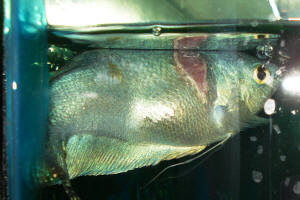 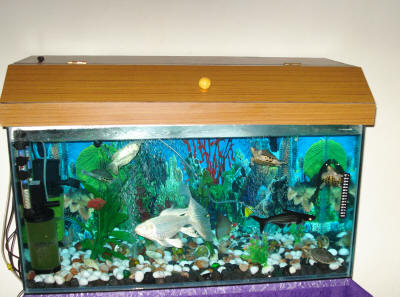
|
Re: Three-Spot Gourami's "swollen
stomach" and a "big red wound" on its right
side.
But Sir,
What is the solution to heal my fish? The environment in which I
treated my fish was Temperature:31 Degree Celsius
Place: Bucket
<I want to be clear, and unfortunately blunt w/ you. There is
little chance of this fish's recovery under the present
circumstance. IT needs to have the turtles, carp and Pangasiid cat
removed immediately... in other words, only improving the
environment will forestall its loss. BobF>
Re: Three-Spot Gourami's "swollen stomach"
and a "big red wound" on its right side.
Sir I will surely do what you said but I want to tell you that
these fish are quite small.
<... Nalin, you sent an image of all in your tank. They're
not small, but Bonsai'd... being poisoned/dwarfed by their own
waste concentration>
So will they still cause a problem?
<...? Already are... The Trichogaster you wrote about...>
And can you please suggest that where can I send them.
<To other, larger systems>
Also which fish will be suitable with Gourami ?
<Please learn to/use the search tool and indices on
WWM...>
Do you think that turtles might have caused this damage?
<Possibly directly, assuredly a contributing cause indirectly.
B>
Thank You very much
Nalin
Re: Three-Spot Gourami's "swollen stomach" and a
"big red wound" on its right side.
6/16/11
Thank You sir for your valuable response. I couldn't use the
search tool because the page said that my computer was sending
automatic traffic and that Google was sorry about that.
<Sorry re... we are trying out a new search tool... and it IS
broken>
And as you said I will find a big home for them.
Nalin
<Ah, good. Thank you, BobF
|
|
Injured Opaline Gourami? 4/3/11
Heya crew!
<Hello Selena,>
I've been having some problems with my Odessa Barbs.
<Puntius padamya; generally a very peaceful species, and among
the best of the barbs for community tanks.>
They keep chasing and (I'm pretty sure) attacking my other
fish.
<Hmm'¦ would keep an open mind on this.>
My tank is a 55 gallon fresh water tank that is home to 2 Opaline
Gouramis,
<Trichogaster trichopterus; males of this species are
notoriously aggressive towards one another and sometimes towards
other gouramis as well, male or female.>
2 Odessa Barbs, 3 Dwarf Gouramis
<Colisa lalia; these will likely be bullied by the
Trichogaster, and mixing the two genera is generally not
recommended.>
and an Algae eater.
<If this is Gyrinocheilus aymonieri, prepare for trouble! This
species is very aggressive and one of the least suitable fish for
community tanks widely sold.>
My levels are as such; pH -- 7.25 , Nitrite -- 10-15 , Nitrate --
0 , and Ammonia -- 0 . The last water change I did was two weeks
ago; it was a 50% water change.
<All sounds fine.>
I know that Odessa Barbs are school fish,
<Yes.>
but each time I bring home more Barbs, tragedy strikes. The first
two times I lost Barbs was due to my pump.
<This shouldn't happen'¦ barbs can swim well,
and unless your aquarium filter is insanely overpowered for the
size of the aquarium, healthy barbs should have no trouble
keeping out of the inlet. In almost all cases where fish *seem*
to get sucked into filters, those fish were already weak or dead,
and merely drifted in.>
The piece that sucks in the water fell off and well... killed my
smaller fish. After this happened twice, I went out and bought
some Aquarium Silicone to firmly attach the tubing to the
pump.
<OK.>
The third time I lost potential Barbs mates was after I brought
home two more Barbs. These Barbs didn't even make it until
the next morning. Both died and the LFS lost some of their Barbs
too.
<Shop elsewhere? Puntius padamya isn't delicate, but it is
a subtropical species, and needs to be kept between 20-25 C/68-77
F. Some aquarists (and retailers, it has to be said) assume the
species is a tropical one, and keep it much too warm. This
stresses them, and in the cramped conditions of the average
aquarium, they don't last long. Aim for >
Anyhow, after this I gave up on having more than 2 Barbs.
I've been trying to find homes for 2 I own instead. In the
meantime though, they have been chasing each other and my other
fish on a daily basis and occasionally nipping at my poor
Gouramis.
<I see.>
My Opaline Gourami has been chased quite frequently and I'm
not sure why they pick on him. He is the biggest fish in the tank
(4-5 inches) and spends most of the day in his ship. Two days ago
I noticed that his side fins were red (close to his body) and I
got concerned.
<Could be the barbs, but normally barbs nip the ends of fins,
on gouramis, especially the pelvic fin "feelers".
I'd be sensitive to the idea that the two Trichogaster are
attacking each other, because these can do more serious damage to
the base of the fins, which is what you see on your specimen,
with the blood at the pectoral fin base.>
When I tested my water, it was perfect. Since he didn't look
sick nor showed any signs of fin rot, I decided to play the
waiting game. Today his one fin is all red and bloody looking.
The other fin is redder than two days ago, but isn't as
bad.
<You might try a preventative for now, like Melafix, but in
good conditions and with the cause of damage removed, this should
heal. If you see any sign of Finrot, then switch straight across
to using a suitable antibacterial or antibiotic.>
I tried taking some pictures but ended up having to make a video
and take pictures of the video to get an image that wasn't
blurred. I attached two pictures for you and I hope they help.
I'm guessing that my Barbs did this to him and in which case,
is there anything I can do to make my Barbs less aggressive? If
this isn't my Barbs and it's some kind of illness I
haven't heard of, do you have any advice? Thank you very much
for your time, Selena
<Some bad choices in terms of tankmates, Selena, and I'm
fairly sure this isn't an "illness" so much as a
social problem of some sort. Cheers, Neale.>
|
|
[1]%20tric.jpg) [1]%20trich.jpg)
|
|
Re: Injured Opaline Gourami? 4/3/11
Hello again,
<Hello Selena,>
So I got some Melafix this morning and added 5 teaspoons to my
tank (55 gallon tank.) Now it says to remove the carbon insert if
possible.
<Yes.>
My filter/pump is a Whisper EX 70 and as such all three stages
are combined into one insert.
<Oh; this is why I do not recommend people use filters that
don't allow them to remove carbon. In any case, if the carbon
is more than 4-6 weeks old, it's effectively "dead"
so far as absorption goes, so forget about it.>
The top of the water is now getting bubbly/foamy'¦
<Happens with Melafix.>
Should I turn my pump off and remove my inserts completely? Or
should I leave them in and running?
<Removing more than half the biological filtration at once
will of course create major water quality problems. Understand
that, and act accordingly. I'm not familiar with your
particular filter, so you'll have to work out the details
yourself!>
Please let me know, Selena
<I do note you haven't said anything about fixing the
social problems in your tank. Melafix isn't a cure-all (Bob
would say it cures nothing, and creates it's own
problems)<<I would; it does. RMF>> and relying on
this, at best, very mediocre medication to make everything all
right in your aquarium isn't going to work. Cheers,
Neale.>
|
Gold Gourami Tail Trouble 2/7/11
Dear Crew,
I am 11 years old, and a year ago, I started an aquarium. It went well
for a really long time. Just recently though, my Gold Gourami has been
getting picked on. I don't know who is doing it though.
These fish are in my tank.
* 1 gold Gourami
* 3 purple passion Danios
* 1 mountain minnow
* 1 (I am not sure) Barbed(?) Pleco.
* 1 bronze Cory catfish
* 2 rapidly growing yo-yo loaches
<Mmmm... none of these "stand out" as very potential
aggressors here>
At this point, the Gourami has one feeler, several white sores, and
half a tail. It is having a lot of trouble keeping afloat, and the fins
behind the gills are always rapidly moving. Stress Coat hasn't
helped at
all. It is in obvious pain, and I am wondering in I should end its
pain.
Should I put it out of its misery? I am so worried!
From,
Sarah
<How large is this system? Do please read here:
http://wetwebmedia.com/FWSubWebIndex/ttriccompf.htm
and the linked files re this species above. My hope is that by such
perusal
|
|

